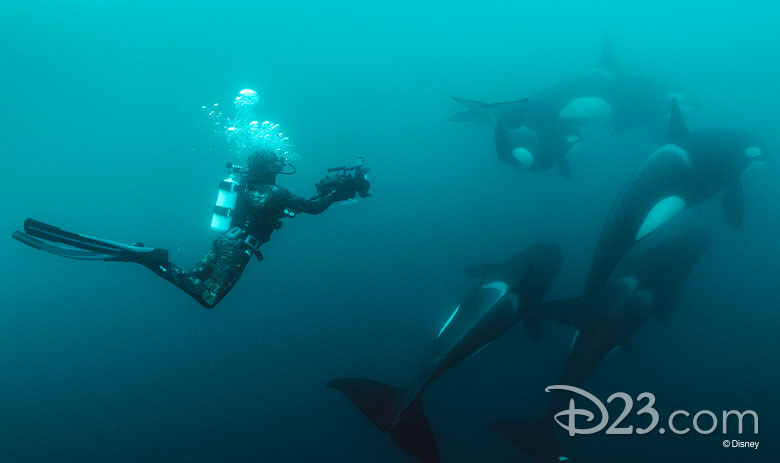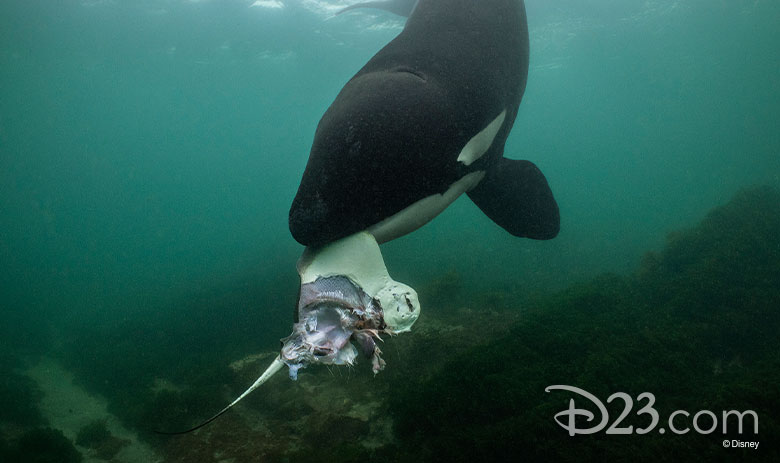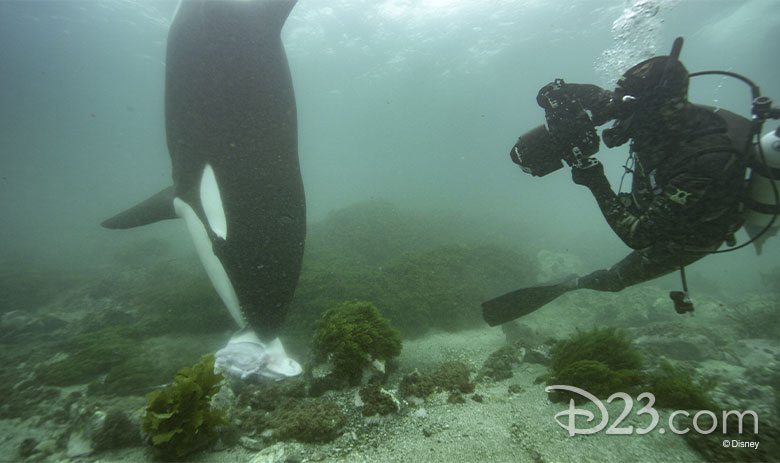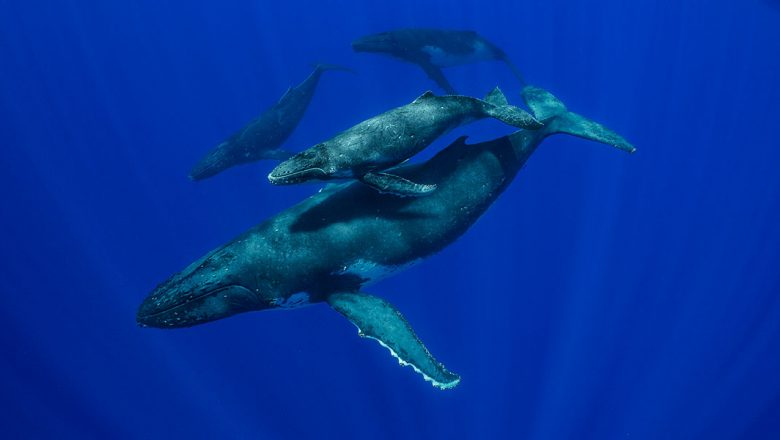By Max Lark
The Disney+ Original Series Secrets of the Whales, premiering tomorrow on Earth Day, is an eye-opening, heart-tugging, and incredibly revealing story of some of the most amazing creatures on Earth. The series plunges deep into the cetacean world to reveal how whales share their own cultural and family traditions much like humans do.
“What we see in Secrets of the Whales are whale cultures that mirror human ones in many respects,” says National Geographic Explorer and Photographer Brian Skerry, who led the team of photographers and scientists behind the Herculean three-year effort to bring Secrets of the Whales to life. The four-part series is narrated by Golden Globe® and BAFTA Award-winning actress Sigourney Weaver (Alien, Avatar, Gorillas in the Mist) and executive produced by renowned filmmaker and National Geographic Explorer at Large James Cameron (Titanic, Avatar). National Geographic has also released Skerry’s book Secrets of the Whales, and the special May issue of National Geographic magazine, “The Ocean Issue,” is available online and on newsstands now. Also, Music from Secrets of the Whales Original Soundtrack features score composed, produced, and mixed by Raphaelle Thibaut and is now available from Hollywood Records/Disney Music Group.
D23 was lucky enough to enjoy a preview screening of Secrets of the Whales and to talk with Skerry, and we celebrate National Geographic’s majestic triumph with 23 takeaways from this awe-inspiring Earth Day event.

1. Apollo 8 changed our view of the world.
“When we first saw our planet from space from Apollo 8 on Christmas Eve in 1968— in what I believe the most important photograph ever made, ‘Earthrise’—we saw that our planet is this beautiful blue jewel floating out in the darkness of space,” Skerry says. “We could also see that we live on, essentially, a water planet.”
2. The ocean is a mystery.
“It’s often been said that 72 percent of the earth’s surface is water, but a more important statistic is that 98 percent of the biosphere—98 percent of where life can exist on earth—is in water,” Skerry says. “It really is in our interest to explore this watery world and to understand it and protect it.” As National Geographic magazine’s “The Ocean Issue” points out, the ocean boasts the world’s tallest mountain, the mostly submerged Mauna Kea, and lowest depth, the Mariana Trench. More than 80 percent of the seafloor has yet to be mapped fully.
3. Secrets of the Whales was a monumental effort.
Filmed for more than three years in 24 locations using state-of-the-art camera technology and the latest scientific thought on whale culture as the basis for its story, Skerry says he and his team gathered 179 terabytes of data—“more than the Hubble telescope gathers in a year.”
4. Trying to capture whales on film is never easy.
“Three years sounds like a lot and so do 24 locations, but the truth is the gems, the jewels, those special moments that you see in Secrets of the Whales, come down to a few moments, minutes, and even seconds,” Skerry says. “Consider Dominica in the eastern Caribbean. I went there on three or four different trips. The first year [2017] I went there for a month. And in that time I got one photograph. So I said, ‘Next year I’m going there for five weeks.’ And that year in the first 19 days, we didn’t see a whale. So the reality is this stuff takes time. The weather has to be great. The whales have to be there. The visibility has to be good. I have to get within a couple of meters of those animals to photograph them. They have to be doing something interesting. The sun has to be shining, because I can’t light a whale under water.”
5. Whales are rather like humans.
“It is a slippery slope to say whales are just like us, but they are like us. They absolutely are. We have to acknowledge that they are an alien species that live on our planet, but they are mammals and they do breathe air and they do so many things like us,” Skerry says.

6. Whales teach their children.
“Whales teach their young the skills that they will need to survive, because like humans they are not born with innate traits that they can just have a baby and the baby goes off and knows how to do anything they have to teach them,” Skerry says.
“Whales also teach their children their ancestral traditions, the things that matter to them, their identities, their cultures, the fact that they do things differently within a genetically identical species: For example, the Orca in New Zealand live differently from the ones in Patagonia or Norway.”
7. Whales mourn their dead.
In the first episode of Secrets of the Whales, “Orca Dynasty,” audiences will see a mother with a dead cub, leading it on a funeral procession toward the deep. Mother whales will often stay with deceased cubs for weeks at a time, unable to part with them. It is heartbreaking and heartwarming to watch at the same time.
8. Whales are empathetic.
Also in episode one, watch an Orca tossing a ray toward a submerged Skerry, having decided that (to the whale) the rather tiny six-foot-tall diver/photographer is in need of sustenance.
9. Whales sing.
When male humpbacks—one of five whale species that sing—arrive at their mating grounds, they break into song. “It’s a fascinating part of whale culture,” Skerry says. “They usually invert their bodies tail up, head down and lie motionless, and for 25 minutes or so, they will sing a song. It’s a new one every year. And there’s competition. The males will compete with certain tune and when they agree upon the winning tune—It’s the American Idol of the sea!—it gets passed across the entire ocean. All the male humpbacks will copy that song for the most part.” Check out National Geographic magazine’s “The Ocean Issue” to read more about whale singing and see the musical notation for a whale song recorded and translated into human music by composer David Rothenberg.
10. Mothers know best.
Most whale species travel in in matrilineal family pods for life who teach their kin how and what to eat. As described in National Geographic’s “The Ocean Issue,” in 1970 when wild Orcas in Canada were still being caught for marine parks, captured Orcas who were raised not to eat fish refused to eat salmon until the 79th day of captivity.

11. Whales are smart.
Orca whales know that if you turn stingrays upside down, they fall asleep, making capture easier.
12. Whales use coral to amplify their song.
The horizontal humpback whale uses coral to send their latest hit across the ocean. Horizontally inverted, they sing into coral to send their song through the water.
13. Whales use advanced sonar to hunt their prey.
In the series’ first episode, we learn that Orca whales use sonar “better than any submarine” to detect prey that hides in the deep darkness of the ocean. It’s incredible to think that a creature longer than a city bus uses sound to detect prey at depths a mile or more below the sea’s surface.
14. Hearing whales sing is a profound experience.
“When you hear it, it’s like nothing else on Earth,” Skerry observes. “You’re in the water, and even if you’re not close to them, it resonates through your body. You vibrate with this haunting sound. We call it a song, but it’s this lyrical melody that might sound in places like a creaking door, or a crying baby, or someone hiccupping. It’s all these little chirps and moans in high and low frequencies. Incredible.”
15. Secrets of the Whales is a game-changer.
“The difference is that Secrets of the Whales is a story,” Skerry says. “When I created Secrets of the Whales, I knew what we could do is an amazing story. We have scientists who are writing scientific papers about the fact that these whales have culture, they talk they sing. We can look at these animals through the lens of culture, and that’s a game changer.”
16. Studying whales is pretty darned amazing.
Being in the world of these magnificent creatures is “awe-inspiring,” Skerry says. “If they choose to let you in, let you interact with them, it’s amazing. You feel very small. You’re this six-foot-tall human and you’re next to this 40-foot-long whale. But they’re always extremely careful about you. A humpback has these huge pectoral fins—wings on the sides of their bodies—and if they’re swimming past you, they will lift their pectoral and go around you so you don’t get struck. They are very aware of you and your position in the water. When they pass, you bounce in their wakes. You feel the swell. It’s like a ride, but I never get tired of it.”

17. Secrets of the Whales wasn’t intended to be conservation documentary—and became a compelling one.
“Secrets of the Whales didn’t start out to be a conservation story, but it turned out to be one of the most important conservation documentaries ever done,” Skerry says. “It’s not about bad news. We’re not showing people doom and gloom. But yet it’s a game changer. If you see things that way and you realize our connection to the natural world through the lens of culture, these families, that is what we have to do to save the planet.”
18. Skerry and company made a rare visit to what he calls “beluga beach.”
“I designed and built these remote cameras to capture beluga whale behavior we’ve never seen before,” Skerry says. “We captured footage of baby belugas that no one had ever filmed before and we see them using gravel as a natural luffa to exfoliate. But one of the real surprises we discovered was their game play. One will pick up little rocks and swim and drop it, and another one picks them up. How wonderful is that? They make time for social bonding moments—a great reminder for all of us.”
19. Herman Melville got it wrong.
The author of Moby Dick misread whales. “Melville portrayed them as leviathans and sea monsters, and we know today that they have the biggest brains on the planet,” Skerry says. “They are shy, they are gentle, they’re loving. They have empathy. And even though living in the ocean is difficult for them and they spend most of their days in hundreds of meters of darkness and cold foraging on squid, they make time every day or every few days to come together and socialize. If you spend time with these whales, every few days you will see them at the surface just rubbing and gently biting and playing, they close their eyes in pure bliss and they reaffirm family bonds.”

20. Now is the perfect time to tell this story.
“It wasn’t that long ago that I would go off on assignment for a few months for National Geographic and shoot 500 rolls of film and have no idea what I was bringing back,” Skerry says. “The dynamic range of new cameras like the RED Gemini let us free dive and see whales using a camera that has 64 or more f-stops in dynamic range so in post we can bring out detail and witness amazing behavior that a year or two before we couldn’t have captured. We’re using gyro-stabilized systems on a boat with a 1,000 mm lens on a Phantom [high-speed] camera that can shoot 1,000 frames a second, and we’re able to catch a breach of a humpback whale in an intimate way and see incredible detail—water dripping off the barnacles on the ventral side [underside] of a whale, creating intimate portraits of these animals on the surface.”
21. Drone cameras provide unique ways to witness whale culture.
“With a drone you can see socializing behavior we’ve never ever seen before,” Skerry says. “You can take one pelican case [carrying case] to anywhere in the world where there is very little infrastructure or it’s too cost-prohibitive to rent a Cessna or helicopter, but now with one suitcase we can launch a drone and not only see things but capture it in 4k or 6k. All of these tools are extremely important for telling the story we wanted to tell.”
22. National Geographic, like Disney, is a one-of-a-kind company.
“The reality of the world is that it is very expensive to do this exploration,” Skerry says. “It’s not easy. Particularly when you study oceans. We have to charter boats, we have to travel to remote places we have to stay there a long time. To get the funding is one thing, but to have an infrastructure that is 130 years old that understands explorers and what it takes. When you bring back your footage and you’re sitting with the television division, book division, or the magazine division… they take ownership. After 23 years of working at National Geographic, I still can’t believe how excited the internal staff gets about what I or my colleagues are doing. They will debate endlessly about what picture will be the lead story for an article. It’s baked into the DNA of National Geographic. At a time in our history where truth and storytelling are more important than ever, to have the power and commitment of Disney and National Geographic locked arm and arm, going forth with these messages to raise awareness to enlighten people is tremendously exciting. I’m waving the flag for both companies and I think in the time ahead, it will pay huge dividends at a very pivotal moment in human history.”
23. Secrets of the Whales has a positive—and important—message.
“If audiences see our planet, see the ocean, through the lens of culture and these empathetic and highly sentient animals, might that not change our behavior?” Skerry asks. “Might that not help us frame our lives in the context of that intricate machine that we are a part of? We are no longer apart from nature or above it, but we are intimately connected to it. We can no longer dump all that carbon in the air. We can’t put 18 billion pieces of plastic in the ocean. I hope audiences are entertained and love learning more about whales, but if they come away with a deeper meaning, that would be great, too. Hopefully it’s a little of both.”






